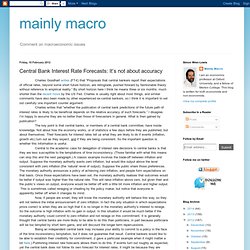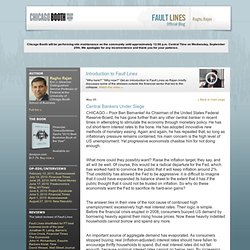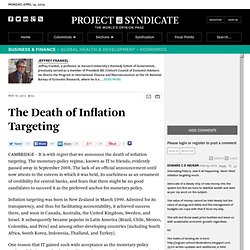

It’s not about accuracy. Charles Goodhart writes (FT-£) that “Proposals that central bankers report their expectations of official rates, beyond some short future horizon, are retrograde, pushed forward by fashionable theory without reference to empirical reality.”

By short horizon here I think he means three or six months: much shorter than the recent move by the US Fed. Charles is usually right about most things, and similar comments have also been made by other experienced ex-central bankers, so I think it is important to set out carefully one important counter argument. Charles writes that “whether the publication of central bank predictions of the future path of interest rates is likely to be beneficial depends on the relative accuracy of such forecasts.” I disagree. I’m happy to assume they are no better than those of forecasters in general. Chicago Booth Blog: Fault Lines by Raghuram Rajan - Fault Lines by Raghuram Rajan.
CHICAGO – Poor Ben Bernanke!

As Chairman of the United States Federal Reserve Board, he has gone further than any other central banker in recent times in attempting to stimulate the economy through monetary policy. He has cut short-term interest rates to the bone. He has adopted innovative new methods of monetary easing. Again and again, he has repeated that, so long as inflationary pressure remains contained, his main concern is the high level of US unemployment. Yet progressive economists chastise him for not doing enough. What more could they possibly want? Viewpoints - Evolution, Impact and Limitations of Unusual Central Bank Policy Activism.
Central banks: Crazy aunt on the loose. Living In A QE World. All Central Bank Balance Sheets Are Exploding Higher, Or Engaged In QE The degree to which central banks around the world are printing money is unprecedented.

The first eight charts below show the balance sheets of the largest central banks in the world. They are the European Central Bank (ECB), the Federal Reserve (Fed), the Bank of Japan (BoJ), the Bank of England (BoE), the Bundesbank (Germany), the Banque de France, the People’s Bank of China (PBoC) and the Swiss National Bank (SNB). Noted on the charts are significant events or growth rates. Shown is the size of each respective balance sheet in its local currency.
Click to enlarge: Comparing Central Bank Balance Sheets For comparison’s sake, we converted the eight balance sheets above into dollar terms. John Kay on Central Bank Credibility « Uneasy Money. John Kay on Central Bank Credibility Few, if any, newspaper columnists are as consistently insightful and challenging as John Kay of the Financial Times.

In his column today (“The dogma of ‘credibility’ now endangers stability”), Kay brilliantly demolishes the modern obsession with central-bank credibility, the notion that failing to meet an arbitrary inflation target will cause inflation expectations to become “unanchored,” thereby setting us on the road to hyper-inflation of Zimbabwean dimensions. (Talk about a slippery slope! If only central bankers and Austrians Business Cycle Theorists realized how much they had in common, they would become best friends.) Here’s Kay: The elevation of credibility into a central economic has turned a sensible point — that policy stability is good for both business and households — into a dogma that endangers economic stability. Like this: Like Loading... Monetary policy: The mandate problem. Seeing Double at Central Banks - Linda Yueh. Exit from comment view mode.

Click to hide this space OXFORD – Central banks are now targeting liquidity, not just inflation. The credit boom of the past decade highlighted the inadequacy of focusing only on prices, and underscored the need for the monetary authority of a country (or group of countries in the case of the European Central Bank and the eurozone) to monitor the financial sector. Macroprudential regulation is the new term of art among central bankers, supplementing their well-established inflation-targeting regimes. This shift in focus could radically change monetary policy, but for better or worse? At the end of a recent discussion with Andy Haldane, the Bank of England’s Executive Director for Financial Stability and a member of the FPC, I asked: What happens if inflation is high and lending is low? I am still pondering the question that I posed to Haldane, because the potential for such contradictory policy imperatives appears unavoidable – never more so than now.
"The Death of Inflation Targeting" by Jeffrey Frankel. Exit from comment view mode.

Click to hide this space CAMBRIDGE – It is with regret that we announce the death of inflation targeting. The monetary-policy regime, known as IT to friends, evidently passed away in September 2008. The lack of an official announcement until now attests to the esteem in which it was held, its usefulness as an ornament of credibility for central banks, and fears that there might be no good candidates to succeed it as the preferred anchor for monetary policy. Inflation targeting was born in New Zealand in March 1990.
Inflation target tyranny. That’s the title of my piece in the Fin last week.

As with my previous column, Catallaxy was out with a comment long before I got around to posting here, but it seemed to me to miss the point fairly comprehensively.